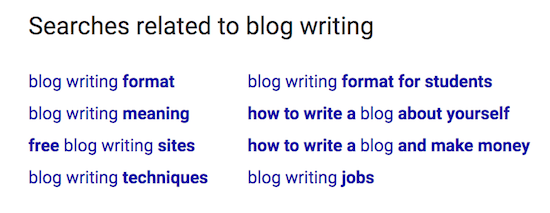
Learning how to write a great blog post is not as easy as it sounds. Every day, millions of people are writing blogs or creating content for digital marketing.
However, most of them fail to attract many readers or have a very high bounce rate.
It happens because they lack the essential elements in their writing to grab a reader’s attention and get a high ranking on search engines.
When you take all the time and effort to write a piece of content, you want people to read your great blog post.
How to attract new blog readers
The quickest way to get some readers after writing blog posts is to promote each new post on social media.
In the short term, it is useful and works quite well.
You might attract a few hundred people to read each of your new articles.
Depending on which social networks you use, you could get some shares and likes, and if you are lucky, a few comments.
But after a few days on Facebook or X (Twitter), your great post will be off the radar and lost forever.
Social media is never a long-term solution.
The only way to get good traffic to your blog over a long period is to start writing for humans and machines.
Or, in other words, for readers and for search engine crawlers and algorithms.
To do this, you need to use a little search engine optimization (SEO).
But don’t panic at the thought of learning how to use SEO.
The three basics
In this article, I will give you some simple tips that you can use to help you improve your blog writing and content.
When you apply these few simple techniques to your posts, you will improve your blog very quickly.
You only need to do three things.
1. Use sensible keywords
2. Write TO and not AT your readers
3. Refresh your existing articles
Content marketing or marketing your content?
Any advice on how to write a great blog post starts with creating a good user experience by writing for your readers.
It is very true and sound advice for all bloggers.
But it is often missing one vital ingredient. How are you going to attract readers’ attention?
It doesn’t matter how well or brilliantly you write your post or article.
If readers can’t find or come across your new post, how can they read it?
Content marketers know this fact all too well. Now, you might not be trying to sell anything.
But you can take a tip from them and learn how to employ basic SEO strategies to market your content and make it more discoverable for readers.
Research your target keyword
It’s essential to spend some time finding a target keyword and a few associated keywords. Do this before you start writing your blog post.
These keywords will help you to get your new post indexed on Google, Bing, and other search engines.
When search engines index your post, they will assign keywords to it and give each one a ranking factor. The more keywords you can gain, the better.
If only a few can get a high ranking, then you are on your way to getting much more organic blog traffic.
The critical point to note here is that one blog post can gain a lot of keywords from Google and Bing.
As an example, one of my posts, which was only 650 words long, gained over 1,100 keywords.
I chose only two keywords when I wrote the post. They were word to epub and word to mobi. But from the text, Google assigned over 1,000 associated search keywords.
Most of them attract very little traffic, but the top five or six are highly ranked and deliver bundles of organic traffic every day.
If you can get this type of result, your post or article will then continue to attract new readers for months or even years to come.

Choosing a topic and your keywords
You don’t need to change your writing process a lot.
There is only one key difference when you sit down to write.
When you come up with new blog post ideas, do what content writers do, and take the time to do a little extra research for singular and plural keywords.
You want to find words and phrases that people really use when they search for articles or answers on your new topic.
The easiest way to do it is to do a simple Google search. Scroll down to the bottom of the first search results page, and you will find related search terms.

You can then click on any one of the suggestions, and you will get eight more ideas on the next search page.
You only need to spend five to ten minutes doing your research. Select between three and six search terms that relate closely to your idea, and you are ready to write.
There is another way to enhance your keyword selection.
You can consider using semantic keywords to enrich the theme of your blog post topic. Adding these keywords will help increase your ranking prospects.
Of course, if you have access to SEO keyword tools, you can dig a lot deeper to find competitors ranking keywords.
Then, you can check the ranking keywords that blogs in your subject area have gained, but you have not.
By using known ranking keywords, your chances of ranking for a new article are then much higher.
How to write a blog post around keywords
Select the best one of your keyword phrases and include it in your H1 title, Seo title, and meta description.
You can use a headline analyzer to help you write an attention-grabbing title around your keyword phrase. You should also include it once or twice in your main body text.
The reason you need to include your keyword phrase four times is to tell search engines exactly what your article is about.
Algorithms are very smart now, but you still need to treat them a little bit like a four-year-old and mention it four times to make sure they understand.
Now start writing your post as you would always do, and write it for your readers.
The only slight change you have to make is to include your other selected keywords in your text.
The key to good blogging and SEO content writing is to include your keyword phrases in a natural way.
You will often need to use different grammar structures to make sure that the wording stays exactly the same.
On occasions, this is not easy to do. When people search for information or answers, the terms they use can be hard to include naturally in a sentence.
For example, I found a search term on Google while researching this article. The phrase was: blogger free blog sites.
But how can you include such an unwieldy set of words in a natural way into a sentence?
How to incorporate keywords
One simple trick to know is that search engines ignore punctuation.
When you know this little SEO writing trick, it makes things a lot easier when you are trying to incorporate a specific keyword phrase.
To include this phrase word for word, you could write this sentence. If you want to become a blogger, free blog sites can be a great way to help you get started.
Or you could use two sentences. Do you want to become a blogger? Free blog sites can be a great way to begin.
In the two examples, search engines will ignore the comma and the question mark.
One word of warning about selecting keywords. It is tempting to use keywords with the word free, such as a free ebook, a free guide, or free membership.
All these keyword phrases are reasonable, but don’t overuse them for any type of content. If every post you write is about something free with flashing calls to action, you will diminish the value of your blog.
Use a little imagination, ingenuity, and writing skills.
Then, you can use almost any keyword phrase in any post you write. But be selective about the keywords you use.
One word of caution. Don’t overuse your target keyword.
If you use it too often in the body of your text, it will be classed as keyword stuffing. It will often result in a very low search engine ranking.

Writing TO and not AT your reader
The best blog writers build trust over time. They do this by becoming known as experts in their field.
It can take years to build an online reputation and even longer for name recognition. If you are new to blogging or plan to start a blog, it seems like a long road ahead.
But you can start immediately on building trust with your readers. There are two key factors to a great blog.
One is that you offer sound and well-researched advice or solutions on your topic.
The other is that you talk to your readers in your writing. You can do this with very little effort by changing your writing point of view (POV).
POV in blog writing
You might associate POV with storytelling and writing books. But it is a vital element in writing fantastic blog posts, too.
Instead of writing in the first person using I and me, change your writing to the second person point of view using you and your.
With this simple change, you will be talking to and about your readers and not at them.
Look at some of the best bloggers, such as Neil Patel, Darren Rowse, Jeff Goins, Jane Friedman, and Joanna Penn. When you read what they write, you will see that they write their popular posts mostly in the second person.
It doesn’t matter if you are paid to write, trying to earn affiliate income, selling books, or blogging for fun. Never forget the power of you in your writing.
Another factor to consider is keeping your writing in a constant register. It means that you don’t mix formal and informal writing.
Good writing for blog posts is usually informal or sometimes neutral register. Avoid using formal words and expressions such as thus, moreover, hereto, therefore, or hence.
Keep your vocabulary and grammar natural, simple, and easy to understand.
Lastly, always check your spelling and grammar meticulously.

It is never the end
A blog post is never finished. As a blogger, you are in charge of content management.
It means that you can always update, improve, edit, refresh, and, most importantly, make your older posts longer.
Some years ago, the recommended length of a post was between 600-1,000 words. But today, most SEO experts say that an online article should be much longer.
Neil Patel recommends between 2,000-4,000 words or more in his article about SEO essentials.
The reason is that search engines are now much smarter at semantic indexing. It means that longer texts can rank for many, many more keywords.
But do readers like these very long posts? It depends on what information or answer a reader is looking for.
Some look for in-depth help, while others might be happy if they find the answer in the first few paragraphs.
As far as content length goes, somewhere in the middle is perhaps the best answer. But always make sure your most important information is in the first third of your text.
Add more content
If you have some very short posts, go back to them and take a look. Can you improve them by adding a few more short paragraphs? Why not add an image or two?
At the same time, would it be worth incorporating some keywords or changing your point of view?
Many of your older posts are most likely already indexed but are ranking very low. If you can improve some of them, the only way is up.
Another point to consider is that blog posts take time to attract comments and backlinks. Both of these help your ranking.
Your older articles might already have gained some. One tip is to know that comments count towards an article’s total word count.
So, some words within your comments can also add new search engine keywords to your post. If you can attract regular comments, it can really help your article to rank.
But never change your URL when you update or improve an old post, or you will lose your comments and backlinks.
In fact, your old posts are a gold mine for you. If you can improve them over time, each one will help you a little to increase your blog traffic.
You don’t have to reinvent the wheel
Good blog writing is high-quality writing. Always.
But when I check some of the best writing blogs I know of, they often have a very low search engine ranking.
The reason for this is that there is a 100% focus on the art of writing.
But there is almost 0% focus on talking to the reader or helping readers find their articles by using basic SEO.
Remember that you are not writing books or white papers, which are both one-way communication.
Great content writing is about two-way communication through comments, shares, and backlinks.
Make sure that when you write a blog post, you write to your readers and for your readers.
If you do three simple things well, you can improve any type of blog or content writing.
1. For new posts, combine your writing skills with sensible keywords.
2. Change to the second person so that you communicate with your reader.
3. When you have time, go back, improve, lengthen, and update your old posts.
Do these three things, and your blog will improve out of sight in no time at all.
Are there more advanced techniques or tips and tricks?
Yes, of course, there are, and it would be a very long list.
Every day, I read and learn about new SEO ideas and changes to how search engines index web pages.
But the three tips I have noted in this article are evergreen and will continue to work well for you in the future.
Related Reading: Stop People Copying Your Writing – It’s Impossible
Share This Article



Very interesting and informative. Very much appreciated.
I am having trouble finding a free blog site…
There are plenty of choices.
But for me, wordpress.com is the best free solution.
Thanks for this straightforward information, this will help the newbie blogger like myself. Keep up!
Thanks for these good tips. I’m saving this.
This was very helpful.TY